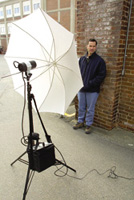Visatec Litepac
A Portable Masterpiece
In my quixotic search to find the perfect location strobe system I've used and owned practically everything--including dry-cell powered Matadors in the 1970s to Norman 200bs in the '80s to Lumedynes and Hensels in the '90s, I've tried everything. For years I trudged about the country with Balcar P2 battery-powered stuff, constantly wondering whether my battery would hold a charge long enough to get the shoot done. While I've pined for a slick Balcar Concept B3 system, my system now is a voltage inverter and a car battery, hardly a "portable" solution. Last year I stumbled across the Broncolor Mobil system at a Sinar dealer on the West Coast. This looked like a perfect setup, a tiny power pack with user replaceable gel-cell batteries and even tinier lamp heads that also have modeling lamps for on-set lighting evaluation, and an AC adapter to use the system in the studio. Perfect? Just about. Cheap? Not really. The full system was just a bit too much strobe for me. Recently Visatec, the offshoot of Bron Elektronik AG that aims more for the working portrait, wedding, and location photographer, introduced a slightly modified version of the Mobil. Called the Litepac, it offers a near perfect combination of power, portability, and value. Unlike the 1200 ws Mobil, the 600 ws Litepac doesn't offer an AC adapter for studio work, but does feature one of the most amazing battery performances I've ever encountered. Power Options |
|||
While the Hensel Porty has become a staple in the location photography world and offers 1200 ws, there still is a hole in the marketplace for portrait and wedding guys. My own location strobe system was a workhorse, but I constantly battled the battery life issue. Some days I got 80 pops, some days only 50. It all depended on how long ago I had charged the battery, how hot or cold it was, and how fast I shot. When Visatec sent me a complete Litepac system for review I seriously doubted their claim of a nearly unbelievable 280 full power flashes. Sleek Design The Setup |
|||
As with most Bron strobe products, the control panel is configured for worldwide consumption. This means that controls are marked by cryptic Euro-speak designations. The slave on-off switch says "Cell," the fast/slow recycle button says "ECO," and the on/off switch says "OI." You learn it fast enough but when you hand the pack to your assistant and tell them to set the pack up for "slave on, modeling lamp off, fast charge" they'll give you that blank stare that many assistants are awfully good at. A few Avery laser labels will fix that fast, but I sure would prefer a language-specific overlay. Once powered up you find that the integrated 50w halogen modeling lamp is actually fairly bright, but totally useless in all but near darkness once aimed through a softbox or bounced into an umbrella. For direct flash use it's bright enough. Obviously the modeling lamp will seriously degrade battery life, so I shut it off and got to shooting. For a location assignment in a dark and dingy factory I shot 11 rolls of Velvia in a Mamiya RZ with both of the Visatec lamp heads parked behind a large machine with red gels, and the unit fired flawlessly for the duration of the 41/2 hour shoot. That's 110 full power flashes plus probably 30 more for metering and Polaroiding--figure 140 flashes. Wow! I've never had that kind of battery performance. The film looked great, with the Visatecs pumping out consistent flash output without a single missed frame. Battery Performance |
|||
While the battery life is nothing short of amazing, there are still some idiosyncrasies that a photographer has to keep in mind. Like all battery-powered flash units, the Litepac likes to be operated with a freshly charged battery. Not a fully charged battery, a freshly charged battery. This means that even if you don't use the battery after charging, firing it up a week later will result in a greatly diminished lifespan. Also keep in mind that while the unit may bang out 250 flashes when freshly charged, I found that after firing off 60 shots with a freshly charged battery I only got another 20 pops when fired up three days later without a charge applied in the interim. This is standard for units like this. My biggest complaint with the Litepac is actually the carrying case. It's a nice looking case but requires you to practically peel it off the pack like a banana to get to the flash sockets and flash sync outlet, which is difficult because the case isn't really designed to peel off in such a manner. It's a poor design and it really should be looked at. (Just adding a flap on each end of the bag would allow for nearly instant access.) In addition, the flash sync outlet is recessed into the pack and is one of those mini 1/8" phone plug connections. In other words, not only do none of my 1/4" phone plug cables, slaves, and radio remotes work, but neither do my heavy-duty 1/4" to 1/8" adapter plugs. (They're too fat to fit.) That said, Visatec does include a very nice 16 foot cable with a sync plug on one end. The Litepac system from Visatec is a wonderful adaptation of Bron's excellent Mobil location strobe system. For almost all people photography 600 ws is plenty, and the sterling battery performance will absolutely spoil you. The standard location kit carries a suggested US list price of $2131, and includes the pack, battery, charger, LP1 lamp head, sync cable, and travel bag. Adding a second head adds another $551. Replacement batteries are only $151, which seems awfully inexpensive to me. (Even better, the packs appear to be loaded with relatively standard 12v gel-cell batteries, so reloading the battery carrier should be a piece of cake for your strobe repairman.) The most appealing accessory is the RF 5500K daylight-balanced ringflash, which is fairly priced at under $1000 ($971). If you're a wedding, portrait, location, or commercial photographer, you'll definitely want to take a good look at the Visatec Litepac system. Check them out at www.hasselblad.com. |
- Log in or register to post comments





































